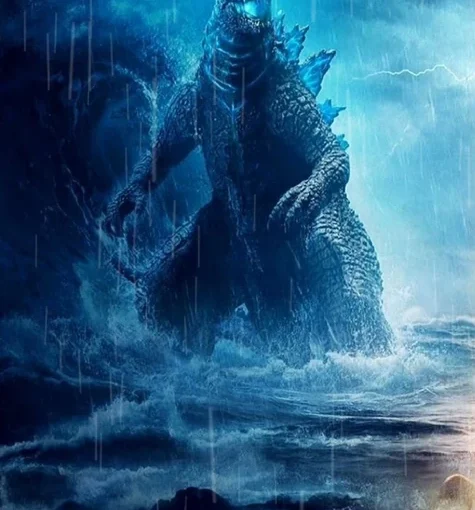Seventy years after his first appearance in the 1954 Japanese film Gojira, Godzilla has become a global star. Meanwhile King Kong, his gigantic Hollywood counterpart, has been circling the globe for a shade over 90 years. The two come together in Godzilla x Kong: The New Empire for the second time in the MonsterVerse film franchise, this time as unlikely partners protecting the Earth.
Godzilla’s globalisation began early in the character’s life. In 1956, Gojira was remade, with new scenes starring Canadian actor Raymond Burr as a US journalist explaining the film’s action to American audiences. The local and transnational politics of the Godzilla franchise have been mutating ever since.
Godzilla began as an post-war destroyer of human cities like Tokyo, but over time the character has shifted, occasionally becoming humanity’s protector, an eco-warrior and even (infamously) a father in Son of Godzilla in 1967.
The MonsterVerse films, which began with Godzilla in 2014 have replayed as many of the Japanese franchise’s main themes as it has remixed and amplified them. Across five films, the MonsterVerse has emerged as slick, well-defined giant monster mythos that has further globalised Godzilla – and King Kong along with him.
Nuclear Godzilla
In the original Japanese film, Godzilla is awakened by American atomic bomb testing in the Bikini Atoll. He represents a warning about the dangers of nuclear power. But by contrast, in the MonsterVerse, nuclear power stations and bombs are used routinely to “power up” Godzilla.
This is taken to new extremes in Godzilla x Kong. Godzilla not only absorbs the nuclear radiation from a power plant, but also turns quasi-cannibal, killing the sea-serpent Titan Tiamat to absorb its power.
This extra dose of radiation results in a radical new look. Each of the Titans (ancient gigantic creatures) in the MonsterVerse has its own colour scheme. Tiamat’s signature colour is pink, and so for the second half of Godzilla x Kong, Godzilla shines with rosy radioactive hues.
Kong goes subterranean
The MonsterVerse has added the idea of the “Hollow Earth” to bolster Godzilla’s murky origin story. Hollow Earth is a longstanding myth about a world existing inside our own, which has been the subject of conspiracy theories.
In the MonsterVerse, the Hollow Earth is a pre-modern landscape filled with Titanic creatures.
In Godzilla x Kong, King Kong is in Hollow Earth searching for his lost species. In this way the film is something of a sequel to director Adam Wingard’s 2021 Godzilla vs Kong. In it, Kong discovers an enslaved giant ape community near the heart of the Hollow Earth, under the control of the Skar King.
The Skar King is another giant ape who controls Shimo, the Titan whose icy breath brought on the last ice age. Defeated and badly injured in his initial attempt to free this giant ape community, Kong turns to his human friends from Monarch (the subject of Apple TV’s Monarch: Legacy of Monsters) for help. In a nod to the popularity of the Transformers franchise, Monarch provides Kong with an exoskeletal arm with which to fight the Skar King.
When Kong and Godzilla finally come together they make inventive use of the Hollow Earth’s passageways. Ever since Godzilla began travelling these tunnels to destroy global cities like San Francisco (in the franchise’s first film), the MonsterVerse filmmakers have been carefully selecting famous global cities for the Titans to use as wrestling rings.
In Godzilla x Kong alone, Godzilla’s battles take place in Rome, Egypt and the Arctic. The Skar King’s obsession with the surface world brings him eventually to Rio de Janeiro. The city is burned, frozen and stomped on as Godzilla and Kong face off against their enemies.
Humour in Godzilla x Kong
There is humour in these battles, in which familiar tourist destinations are ripe for destruction. Among the beloved national landmarks reduced to rubble is the Coliseum, which becomes a giant cat bed for Godzilla. But, there is also an industrial logic to the way the locations are being selected.
The Chinese-owned production company, Legendary Pictures, are working with their American studio partner, Warner Brothers, to maximise the MonsterVerse’s global appeal by taking a global approach to these battlegrounds.
Through these familiar cities, the MonsterVerse films are carefully targeted to audiences from across the globe. And, the opening weekend’s blockbuster box office shows that this strategy is paying off. It can even be seen in the transnational casts. Previous instalments of the franchise have featured major international stars like Ken Watanabe, Juliet Binoche and Ziyi Zhang, balanced out by Hollywood stars like Brian Cranston and Millie Bobby Brown.
Aside from the Titans, Godzilla x Kong is largely populated by secondary characters from previous films, along with broadly drawn characters like Trapper, a dentist and vet for Titans (Dan Stevens on scene-chewing form).
This is where the young Jia, played with graceful poise by Kaylee Hottle, comes into her own. Jia is the lone survivor of the Iwi people of Skull Island (wiped out in an off-screen Titan disaster). Hottle, a rising star, is a deaf performer, and provides a signed, subtle performance that supplies the film’s heart.
However, in Godzilla x Kong it seems like the Titans are finally the main attraction in their own movies. As Godzilla and Kong make themselves at home in semi-flattened cities all over the world, the global power of the MonsterVerse is hard to argue with.
![]()
Rayna Denison does not work for, consult, own shares in or receive funding from any company or organisation that would benefit from this article, and has disclosed no relevant affiliations beyond their academic appointment.



